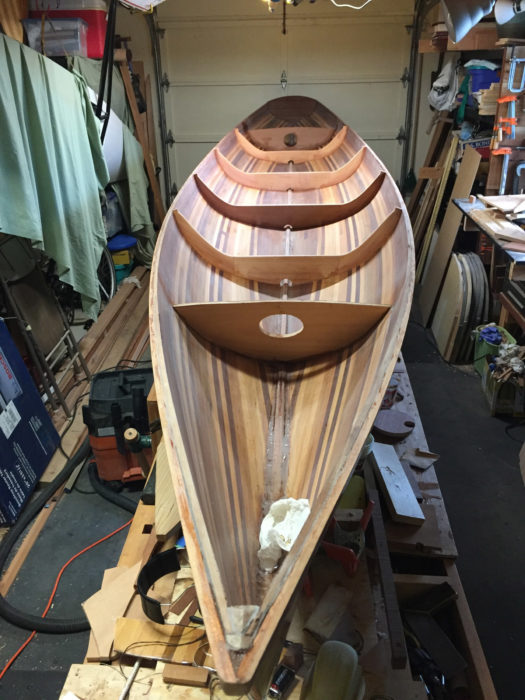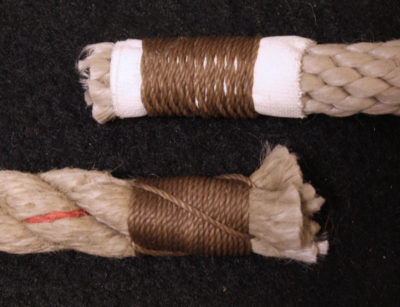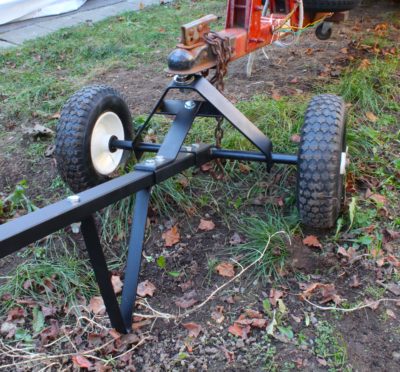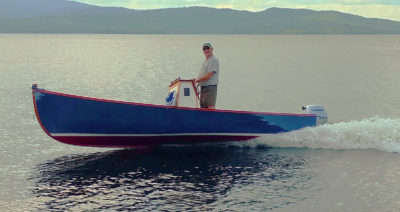When Frank Ward of Port Townsend, Washington, retired after his career as a healthcare cybersecurity consultant, he had a plan for putting his free time to good use and carried it out with enthusiasm. He joined a learn-to-row class at the local rowing club; soon afterward he served on the club’s board. He enrolled in the Northwest School of Wooden Boatbuilding. He did so well as a student there that he was named as one of two teaching assistants for the following year.
 Photographs courtesy of Frank and Cathy Ward
Photographs courtesy of Frank and Cathy WardThe strongback extended its plywood top across the workbench.
His new loves of rowing and boatbuilding set him on a search for a design that he and his wife Linda could safely row on the somewhat exposed waters around Port Townsend. His research led him to the Annapolis Tandem Wherry from Chesapeake Light Craft (CLC). He liked the look of the boat, and it clearly would meet his criteria for rowing, but the plywood kit offered by CLC wasn’t his cup of tea—he wanted the challenges, pleasures, and satisfaction of building a boat from lumber.

The first arrangement for positioning the transom was short-lived. It didn’t survive closing the door at the end of its first day.
Two of Frank’s friends had recently finished building a cedar-strip canoe, and he thought “it was gorgeous.” He resumed his search for a design, hoping to find a strip-built wherry, but kept coming back to the Annapolis wherry. He decided to call CLC and ask about a cedar-strip version of the Annapolis tandem, and the person who picked up the phone was John Harris, the company’s owner and designer. John, it turned out, had already drawn a version of the wherry for strip construction, and he told Frank to visit the CLC website the following day, and the plans would be there. That day, Frank placed his order for the plans and cedar strips.

The support for the transom here is the replacement for the one that the garage door tore off. There were moments in the shop when Frank enjoyed the boatbuilding in spite of the mishaps and cramped quarters.
The wherry is 20′ long and Frank’s single-car garage, at 23′, was barely long enough for the project. The sports car that he was sheltering there could store outside, but the woodworking bench had to stay. There wasn’t enough room for the bench and the strongback for the wherry, so the strongback was built as an extension of the bench.

Frank matched cedar strips to give the hull a symmetrical pattern.
After Frank had the molds set up square and plumb, he placed the transom on the jig to hold it in the right position and the precise angle. That would have been the end of the day’s work, but when Frank closed up the shop, he pressed the button to lower the garage door. It came down like a guillotine and clipped the jig. It went flying one way and the transom took off in the opposite direction. After that mishap he came up with a new jig, which provided the clearance required, a meager 1/2″, but enough for the safe operation of the garage door.

With planking complete, the hull seemed to take up even more room in the narrow garage when turned right-side up.
Before he could begin planking, Frank had to scarf the 8’-long, bead-and-cove strips together, so he made a special jig to speed the process and make stronger joints by cutting the bevel at an angle. He usually worked with the garage door open as an invitation for curious neighbors to keep tabs on his progress. When the molds went up, there was a quick, dramatic display of progress, and the conversations were welcome and encouraging, but the strip planking went slowly, and there wasn’t much to show for a day’s work. When the thrill was gone, the work didn’t go as well and mistakes happened. His workspace was small and there was always something in the way. Linda, on more than one occasion, heard a crash coming from the garage, followed by some strong language, and rushed to Frank, fully expecting to find him gravely injured. She was relieved to discover he’d only lost his temper, not any blood or body parts.

The finished boat was equipped with and sliding seats he built to fit the wherry and Colin-Angus designed outriggers.
After two months of work on the boat, Frank fit the last of the planks and could step back and admire the shape of the finished hull. After planing, scraping, and sanding the planks fair, he draped the hull with fiberglass, and as he filled the fabric with epoxy, the color of the cedar came out for the first time, radiantly.
The neighbors who were checking on the progress were impressed by the beautiful cedar but dismayed that Frank said he intended to paint the hull white. Only the exterior would be painted, he reassured them, and there would be more than enough bright-finished cedar on the inside.
Prepping the interior for varnish was an arduous task. Frank sealed all of the wood with epoxy, and sanding it smooth took a toll on his fingers and wrists. They’d ache for days afterward. For the varnishing, the shop was vacuumed clean, and the garage door came down to keep the dust and the cold out. There was no going around the stern, and Frank had to crawl under the boat to switch sides.

Friends and neighbors joined Cathy (left) and Frank (right) in carrying the wherry to the water on launch day.
Frank launched the wherry with a group of friends and neighbors and christened it FESTINA LENTE, a Latin saying that goes back to ancient Rome and Greece. It means “make haste slowly.” Frank and Linda took the wherry for the first row.

Frank and Cathy took the first strokes aboard FESTINA LENTE.
Not long after the launching, Frank took FESTINA LENTE to the Wooden Boat Festival in Port Townsend. Chesapeake Light Craft had a booth there, and John Harris was in attendance. He noticed FESTINA LENTE and introduced himself to Frank, complimenting him on his work. John said that his boat was the first strip-built Annapolis wherry to be completed, so it has the distinction of being Hull No. 1.
 Michael Lampi
Michael LampiThe new owners, Giles and Cathy, learned to scull on Seattle’s busy Lake Union, but from their house in West Seattle, they could see Puget Sound, and longed to row there. They looked around for a boat that could take on the open water of the Sound. When they saw FESTINA LENTE listed for sale, they immediately fell in love with her lines. “Frank is an artist,” they said, “and he created a work of art that boat.” They row a couple of times a week, and enjoy rowing in the company the seals and sea lions, always striving for the perfect stroke.
After Frank and Linda enjoyed FESTINA LENTE for a couple of years, they put the boat up for sale. It was purchased by a Seattle man, Giles Stanton. He and his rowing partner Cathy Morgan entered the Great Cross Sound Race, a 7-mile out-and-back across Puget Sound. They won their class. That FESTINA LENTE was the only boat in her class shouldn’t be held against her. She’s one of a kind.![]()
Do you have a boat with an interesting story? Please email us. We’d like to hear about it and share it with other Small Boats Magazine readers.












Il motto (che va pronunciato con l’accento sulla “i”: festìna lente) venne associato al simbolo della tartaruga con vela da Cosimo I de’ Medici, che nel XVI secolo ne fece l’emblema della sua flotta, come monito di ponderazione delle imprese perché avessero successo. La tartaruga, animale famoso per la sua lentezza, ma anche sinonimo di prudenza, è abbinata alla vela gonfiata dal vento, ovvero ciò che spinge le navi, quindi sinonimo di forza d’azione. (da wikipedia)
In Italia sul lago di Garda c’è un mio amico che ha una barca a vela con lo stesso nome.
Bellissima costruzione, complimenti
[Ed: online translation from Italian] The name (which must be pronounced with the accent on the “i”: festìna lente) was associated with the symbol of the turtle with sail by Cosimo I de’Medici, who in the 16th century made it the emblem of his fleet, as a warning of weighting of companies to succeed. The turtle, an animal famous for its slowness, but also a synonym of prudence, is combined with the sail blown by the wind, which is what drives ships, therefore synonymous with force of action. (from wikipedia)
In Italy, on Lake Garda, a friend of mine has a sailboat with the same name.
Beautiful building, congratulations
Lovely article, and an inspiring work by the builder.
Festína lente – A wonderful saying, and a beautiful boat.
Love the build. Beautiful work. A few questions:
Was the finished weight of the strip-planked version lighter or heavier than a stitch/glue ply version?
Did the builder keep plans for the oar/sliding seat rigging?
Can the strip-planked version be rigged for a single rower, like the ply version?
I’m researching options for a light-weight, open water single/double expedition-style sliding-seat rowing boat. Not a ton of choices out there. I’m currently evaluating the Derwent Double, but I’ve always loved the Annapolis Wherry.
What impresses me most is the patience of the builder. So many details, so many opportunities for a mistake. so many steps to complete. To stay motivated to continue on onward day by day without resorting to ‘rushing’ a few steps (and then regretting it afterwards). The building process has to be at least as much mental as physical. It helps to love the process as much as the result.
(And I am personally building my twelfth boat).